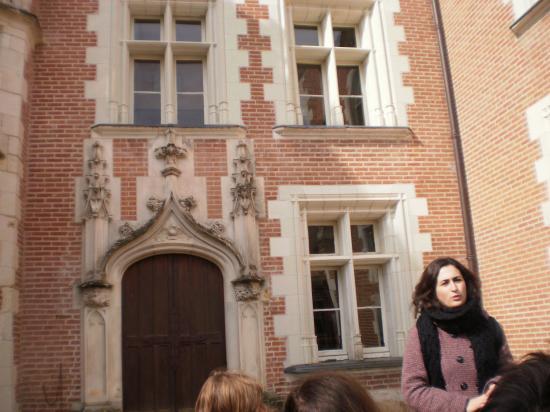Clos Lucé GB
Clos Lucé : 
Last home of Leonardo da Vinci. He died here on May 2nd, 1519.
Francis I asked him to come to France in 1516. He made this résidence available to him and gave him a pension (700 gold écus).
Leo was appointed ‘first painter, architect and engineer of the King ». But what Francis I enjoyed the mos twas having the pleasure of hearing him talk, and he enjoyed it almost every day.
The King and his sister Maguerite de Navarre were really fond of Leo and Francis I even used to call him « my Father ».
Within this friendly atmosphere, Leo was free to work and dream.
The building : limestone and bricks.
It was built 50 years before Leo’s arrival. Late gothic architectural éléments (pinacles, gargoyles, mullion windows, crockets).
Chapel added at the end of the 15th c by Charles VIII.
Leo’s study:
Room where he used to work. Architect, engineer, and set designer: he organized elaborated festivity for the court.
He also drew up plans for a model castle for Francis I, with a system of telephony, self-closing doors, a landing stage and a domestic water system.
+ château and ideal city of Romorantin
+ Sologne-marsh drainage plans
+ dwellings that could be dismantled and re-erected for the court, which was always on the move.
When he was staying here, Leo was old: 65 y. old. But he remained very active as it can be seen from his numerous drawings and sketches in his notebooks.
He worked on nature, geology, anatomy (dissected about 30 bodies) and engineering. He may also have created here the staircase of Chambord.
Leo’s workshop:
18th salons (madame overlaet voulait que je le traduise. Living room?)
Leo used these rooms as a painting studio when he was living here: they are full of light. When he came to France, he brought with him 3 of his paintings. One of them was St John the Baptist (detail du visage sur une commode).
Even if he is famous for his paintings, he didn’t paint much at the end of his life. We even know that his right arm would have been paralysed, thanks to the account of a visitor. That would be an explanation of the fact that he was not painting anymore.
But we also know that he was left-handed. He actually used to write from right to left, so nobody could read his notes without using a mirror.
Here he didn’t paint, he just gave its final touches to St John the Baptist (Louvre).
The kitchen:
The size of the fireplace is quite impressive, but it’s pretty common for that time. Indeed, there was no stove, oven nor cooker. Food, and particularly meat, was cooked in the fireplace (arts de la table).
Thanks to his will, we know Leo’s cook: Mathurine.
He was vegetarian: considered the use of meat as a murder of animals and lived entirely on vegetables.
Park:
Display of Leo’s inventions and works of art.
- 16 giants and actionable machines
- canvases depicting the master’s sketches and paintings.

